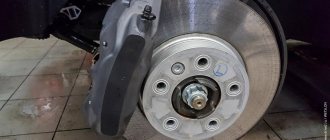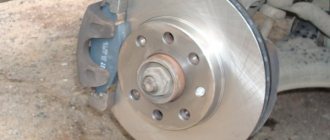Here are several factors influencing the service life of summer tires.
- Tread condition.
- Car mileage.
- Tire pressure.
- Suspension condition.
- Storage.
The first thing you need to pay attention to is the condition of the tread. For summer tires, its depth corresponds to 1.6 mm. Measurements are made using a ruler.
There are also special bridges between the grooves. If the tread pattern has worn down to their level, then the tires should be replaced. Some manufacturers stamp numbers on their tires at different depths. In this case, the degree of tire wear is determined by them.
How long do tires last?
Tire expiration date
according to GOST
Russian legislation sets the service life of tires
car under warranty in accordance with GOST 4754-97 and GOST 5513 - 5 years from the date of manufacture, but for tires, first of all, the main indicator is the quality of the product, and not the time of its use.
Interesting materials:
How to quickly charge the charger? How often do you change antifreeze on a motorcycle? How often to change antifreeze on Renault Logan? How often do you change antifreeze on Solaris? How often do you change 5w40 oil? How often do you change your car oil? How often do you change the oil in your truck? How often do you change mineral oil? How often do you change the engine oil in your car? How often should I change the timing belt on a Golf 5?
To extend the life of summer tires, you need to monitor the condition of the entire car.
For example, a broken wheel alignment will lead to uneven tire wear. Therefore, after repairing the steering drive or replacing shock absorbers, stabilizer struts and other joints, the wheel alignment angles should be checked.
Tire pressure affects the uniformity of tire wear. If the value is insufficient, the outer edges of the tire are worn out more, and if the pressure is too high, the central part of the wheel wears out more.
Many drivers, switching to the summer season, change their tires to the same wheels. Tires from this procedure deteriorate and become less reliable. Experienced drivers advise changing tires along with rims and having two sets of wheels assembled, one for winter and the other for summer.
It is important to note. Wheels should be stored in a cool, dry place, preferably at a constant temperature.
In order for tires to last longer, it is necessary to use them correctly, maintain them on time and store them carefully.
Mileage
Another guideline for changing tires is mileage. You can often find recommendations on the Internet that refer to GOST. Their text reads: for passenger cars with a carrying capacity of up to two tons, the tire service life is 45,000 kilometers.
You can also find references to the operational mileage standards for vehicle tires approved by the Ministry of Transport of the Russian Federation. Their average service life varies from 40 thousand kilometers for Russian tires to 60 thousand for foreign ones. Please note that this document lost force after the entry into force of the Technical Regulations of the Customs Union.
You can also determine how long a tire can run using the Treadwear (TW) parameter, which indicates the tire wear resistance index. It is not often paid attention to. This figure is usually of interest to those who plan to use the car in a sports environment. Soft and, accordingly, grippy rubber has a fairly low TW, which is what racers focus on.
Surely you have a reasonable question about how the wear resistance index relates to mileage. TW appeared thanks to specialists from the National Highway Traffic Safety Administration (NHTSA). To calculate it, the tire at the test site is compared with a special sample, the TW of which is already known.
According to the methodology, TW100 is equivalent to 48 thousand kilometers until the rubber is completely worn out, that is, Nokian Hakka Green, for example, having TW400, can last up to 192 thousand kilometers. True, in the real world, wear is influenced by many factors that we discussed above, as well as driving style. Therefore, it is recommended to divide the calculation results for TW by two. It turns out 96 thousand, or almost 5 years of operation, provided that in the warm season the car travels about 20 thousand kilometers.
Incorrect tire pressure can significantly reduce tire life. Don't forget to check it
In total, we have three parameters that should help you understand how long tires will last if used correctly, and also tell you when to send a set of tires for scrap and bother buying new ones. This can be done on the Kolesa.kz portal using the search form in the “Spare parts” section.
Year of manufacture and signs of wear of winter tires
Despite the declared resource, it is important to constantly monitor the condition of the rubber. The main indicator is the jumpers on the surface of the tires, the wear of which indicates the end of their service life.
You can use a special depth gauge to measure the tread depth. For winter season tires, normal values are at least 4 mm. The focus should also be on deformations, cuts, and bumps that occur after impacts.
Initially, you should focus on the date of manufacture of the product, which is usually applied to the side surface of the tread.
It should be remembered that the performance characteristics of a tire are noticeably reduced during long-term storage without the use of special protective equipment. It is better to give preference to products with the latest release date.
The result of improper storage can be multiple microcracks, which during operation will lead to rapid wear and destruction of the tire material.
The need to replace winter tires is quite easy to determine visually. For example, if more than half of the total number of studs is lost, the tread is worn by 30%, it is definitely necessary to change the wheel.
Depending on the brand, for daily use it is recommended to renew winter tires once every four years.
Thus, the following signs indicate tire wear:
- loss of 60% of spines;
- pattern wear more than 30%;
- tread depth less than 4 mm;
- cuts, deformations;
- bumps from blows.
How long does rubber last and what are the factors of its wear?
Manufacturers usually indicate that tires retain their original qualities for 10 years of operation. If we talk about mileage, they give a number equal to 50-60 thousand km per year. Once these marks are exceeded, further use of tires becomes extremely unsafe and can lead to accidents.
However, in reality, you need to understand that high-quality road grip is primarily affected by tread depth. Of course, depending on various factors, the rate of tire wear may increase.
The condition of the road surface is of great importance: various holes, potholes and irregularities contribute to a sharp reduction in the service life of the tire. According to statistics, when used in Russian conditions, tires retain their usefulness for about 5 years. If the car owner prefers an aggressive driving style, or often drives off-road, then the tires will serve him for a maximum of 3 years.
In addition, the tread wears out faster in the following situations:
- vehicle overload;
- temperature changes (especially in spring and autumn);
- wheel alignment condition;
- original quality of rubber (depending on the manufacturer);
- driving on roads where reagents or technical fluids are spilled;
- ultraviolet radiation.
If you buy tires secondhand, you are taking a big risk, since the previous owner could have stored the tires in a room not intended for this purpose. This leads to the formation of microdefects in the tread, which further aggravate its wear. Thus, tires purchased on the secondary market may become unusable after just a couple of seasons.
By brand
Today there are a huge number of tire manufacturers on the market. We will consider only the main, most popular ones.
The maximum shelf life of all of the following is 10 years from the date of production.
Continental is a German brand that dates back to the 19th century. Continental is supplied as a tire for many cars. It is valued for its traditional German quality, but comes with a hefty price tag.
Dunlop is an old English company, the founder of pneumatic tires. The Dunlop Corporation produces its products all over the world; the most common supplies in Russia are from Asia.
Nexen is a good Korean brand, characterized by regular demand: it acts as a price/quality product, although it is inferior to Hankuk in popularity.
Bridgestone previously occupied a leading position in the Russian market with its IC 7000 model, but recently the Yokohama brand has taken over the baton of leadership among Asian manufacturers.
Nokian (Nokian) is the founder of winter tires. Traditionally, the company is a leader in the winter theme. It has its own testing ground, a very strong representative office and production in the Russian Federation.
Estimating the service life of car tires - should you trust the manufacturer?
In most cases, the manufacturer, indicating the period of use of tires in seasons or kilometers, provides a guarantee for these control figures. In such cases, this information about the period is more likely to be reliable, since if the tires wear out prematurely, the manufacturer undertakes to provide a new set or return the money. This rule only applies to original tires. Firstly, the manufacturer does not bear any responsibility if the tires were not purchased from an official dealer, and secondly, replicas are characterized by increased wear. Their wear resistance indicators have nothing to do with those of the original models.
Wear of tires to marks
Legislation and recommendations of car tire manufacturers
Tires are a shell made of rubber that sits on a wheel rim. The tire interacts with the road, its task is to reduce micro-vibrations from the road surface, as well as compensate for shortcomings in the trajectory of the wheels. It is the rubber that experiences the maximum load. Therefore, after a certain period of time it becomes unusable. Moreover, this period is determined by several factors.
Tires have a shelf life. This is the time during which products do not change their original properties. Of course, provided that the rubber is stored and used correctly. In general, you can drive tires even after their shelf life has expired. However, the technical characteristics of the tires will become worse.
Even if the tires are just sitting in the garage or you don’t drive the car a lot, the tires will still age. After all, rubber is exposed to chemical and physical processes.
To slow down aging, when making tires, rubber is mixed with special substances. They prevent the negative impact of various chemical compounds with oxygen and ozone on tires.
Thanks to this, even if the tires have been sitting in your garage for several years, they will retain their properties and will be as good as new.
Note! The service life of tires and the warranty period of storage are two different things. Under warranty, tires are stored for 5 years, but this does not mean that after this time the tires will become unusable. The fact is that the law obliges the tire manufacturer to indicate an expiration date of at least 5 years in order to protect buyers.
Modern research by American specialists suggests that the duration of storage and use of tires is 10 years. Experts from Germany are confident that after 6 years even new tires become unusable.
To ensure that tires can be used for a long time, they must be stored properly. The list of storage requirements is contained in GOST 24779-81. If at least one condition is not met, the performance characteristics of the tire will decrease. However, even if rubber is stored correctly, its shelf life is not unlimited.
When purchasing or installing tires, pay attention to the production date indicated on the products. It can be used to judge how much longer you can drive on the tires and what their age is. On modern tires, the production date is indicated according to a standard that was approved in 2000 by the US Department of Transportation.
What is the production date? On the rubber you will find an oval molding, in front of it is the abbreviation DOT, as well as a alphanumeric index. The oval itself will also contain numbers and letters. They contain information about the date of manufacture. Look at the last 4 digits, they need to be decrypted:
For example, in the oval-pressure test the numbers are 4709. This means that the tires were made in 2009, in the 47th week. According to domestic and world standards, these tires must be sent to a landfill.
But on some tires there are other designations of the production date. For example, an oval crimp indicates 3 numbers and a small triangle. This suggests that the rubber was made between 1990 and 2000. Naturally, you can no longer drive on such tires, even though they were stored in your garage or you rarely drove the car.
Storage period for tires for cars without use
According to GOST, it is 5 years, but this does not mean that they will be unsuitable.
What is more important here is how they were stored all this time. When changing from summer to winter or vice versa, an unused set must be kept in appropriate conditions so that it will last for more than one season.
Storage conditions
If tires are stored without rims, they are placed on the tread. If on disks, they need to be hung or stacked on top of each other. To maintain elasticity, you will need to lubricate with a special tire care product.
Where is better
A warehouse without a source of direct sunlight, exposure to ozone, or mineral oils is ideal for this purpose. It should be well heated (from +10 to +35 °C), and the humidity should be maintained at a normal level (~ 80%).











